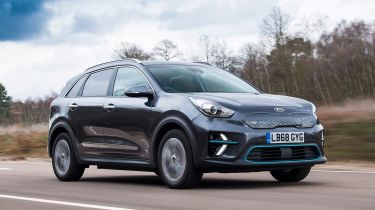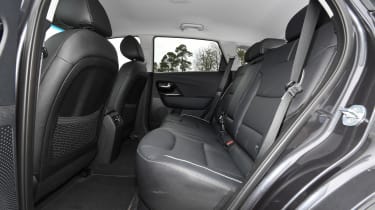Kia e-Niro (2017-2022) review - Practicality, comfort and boot space
Unlike some electric cars, the Kia e-Niro is more practical than its hybrid siblings thanks to clever packaging

There’s no arguing with the e-Niro’s credentials as a family car. It’s a mid-size SUV that looks more like a large hatchback than a rough-and-tumble off-roader, with a shape that’s almost entirely dictated by practicality. There’s space inside for four adults to sit in comfort and the boot is large, while the cabin boasts plenty of storage space – including a particularly useful space where the gear lever would be found on an internal combustion car.
The e-Niro is a relaxing car to drive thanks to a great driving position, clear all-round visibility and great refinement. Overall, the e-Niro beats its nearest rivals hands down when it comes to flexibility for family life – the Hyundai Kona Electric has considerably less space inside, while the i3 is even smaller. These two are a little easier to drive around town as a result, however. Much like other EVs, the Kia e-Niro isn’t rated for towing – it’s worth considering a diesel-powered SUV if you need this option.
Size
The Kia e-Niro is 4,375mm long, 1,805mm wide and 1,570mm tall including its built-in roof rails. It weighs in at a substantial 1,812kg – EVs tend to be heavy due to their batteries.
Used - available now

2022 BMW
X1
21,639 milesAutomaticPetrol1.5L
Cash £21,200
2022 Vauxhall
Corsa
18,816 milesManualPetrol1.2L
Cash £12,600
2022 Skoda
Karoq
23,228 milesAutomaticPetrol1.5L
Cash £19,600
2019 Nissan
Juke
29,935 milesAutomaticPetrol1.0L
Cash £13,400The broadly similar Hyundai Kona Electric is based on the same architecture and is just about the same height and width as the Kia, but is shorter by a couple hundred milimetres.
Leg room, head room & passenger space
The Kia e-Niro is the best EV in its price range when it comes to carrying passengers in comfort. The front seats are very roomy indeed, while the rears offer more than enough space for six-foot adults. ISOfix points are supplied in the outer two rear seats.
There’s more space for passengers in the back of the Kia than in the slightly cramped Hyundai Kona Electric – and there’s a huge difference when compared to the much smaller, more city-focused BMW i3.
Boot
Boot space – while 52 litres down on the capacity of the Kia Sportage – is still a commendable 451 litres. There’s actually more space in the back of the e-Niro than you’ll find in its hybrid siblings – the Niro Self Charging Hybrid has 382 litres, while the Niro Plug-in Hybrid has 324 litres. Fold down the e-Niro’s seats and there’s an impressive 1,405 litres to play with.
The Kona Electric has less load space than the Niro – 332 litres with the seats up, 1,114 litres with them down.









